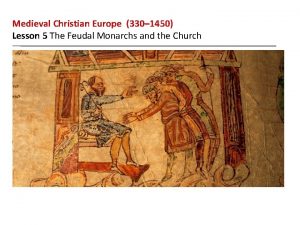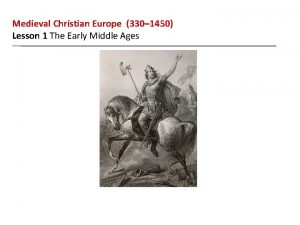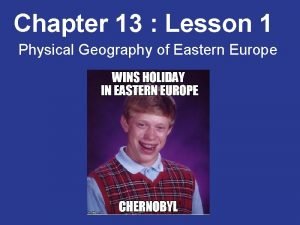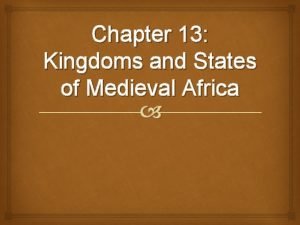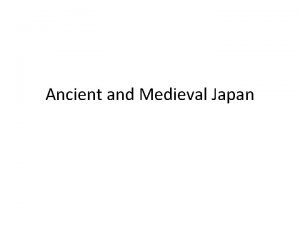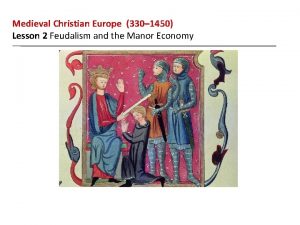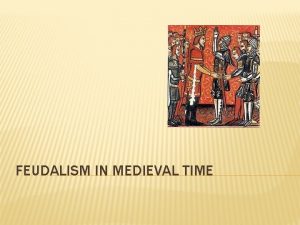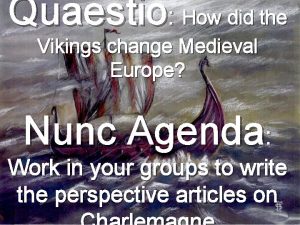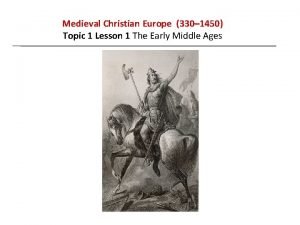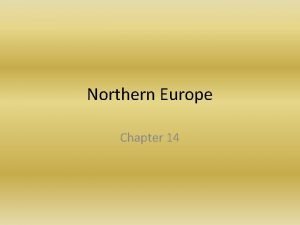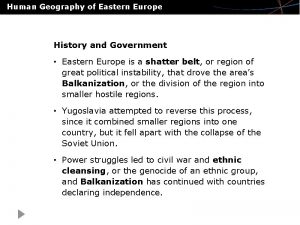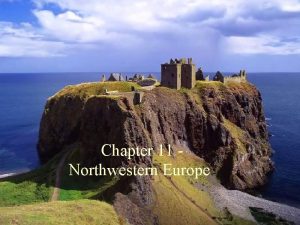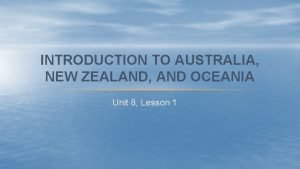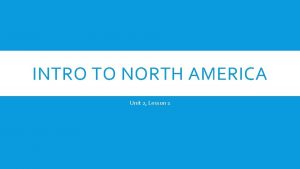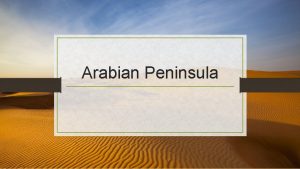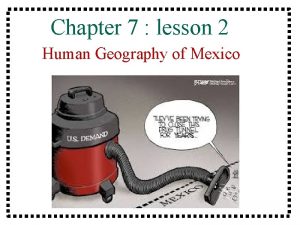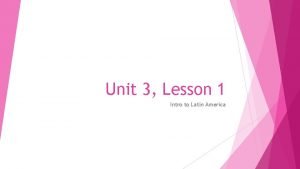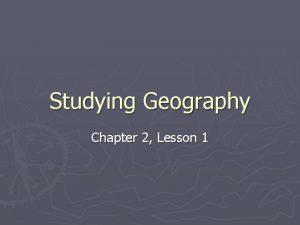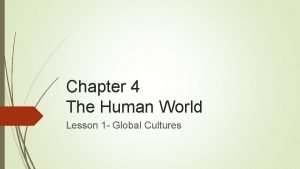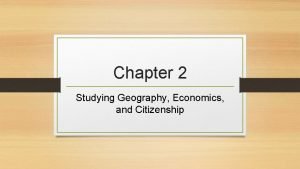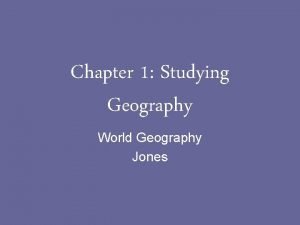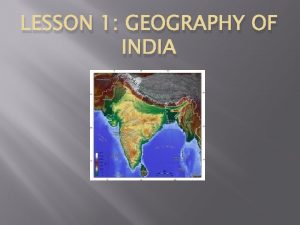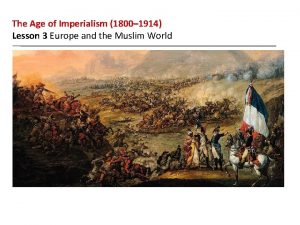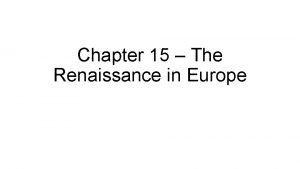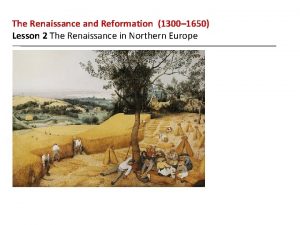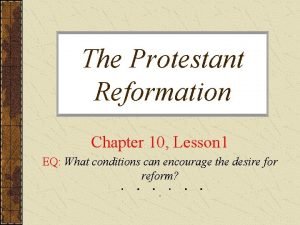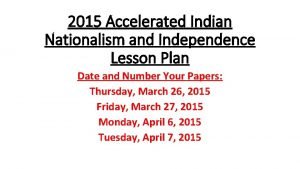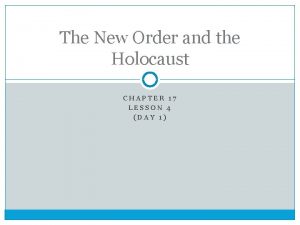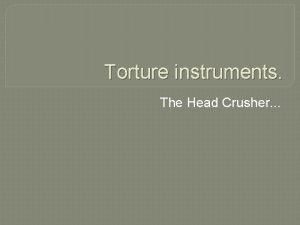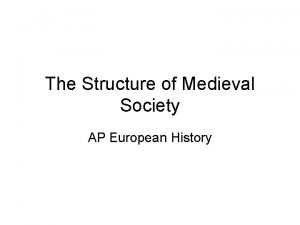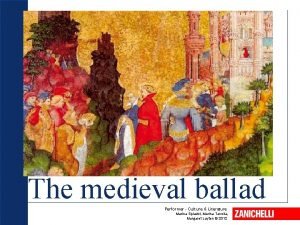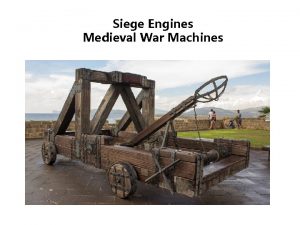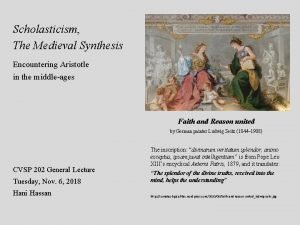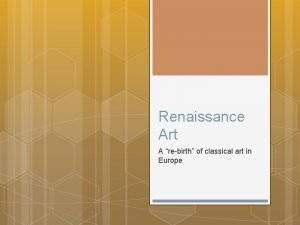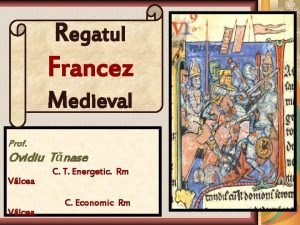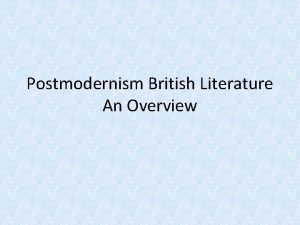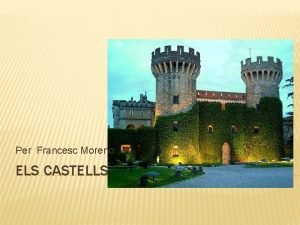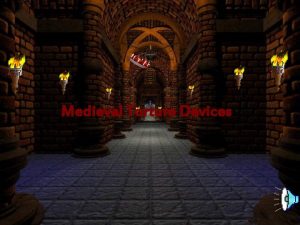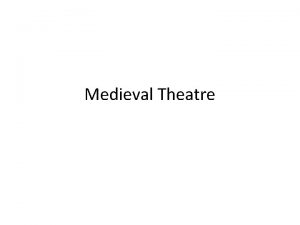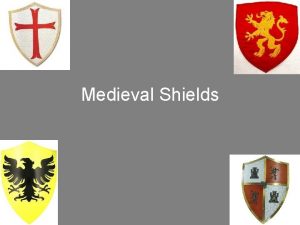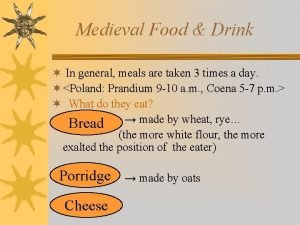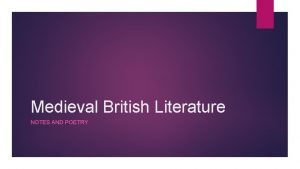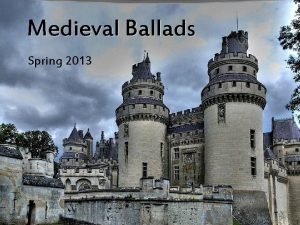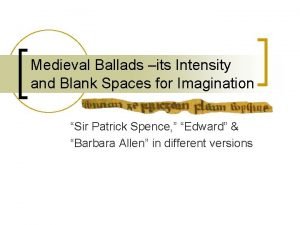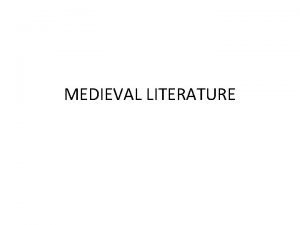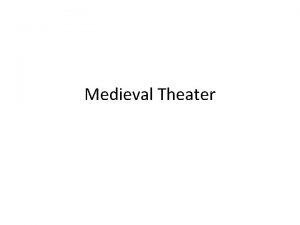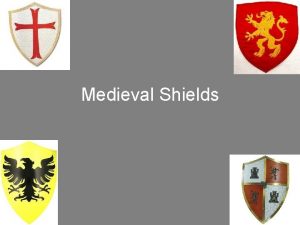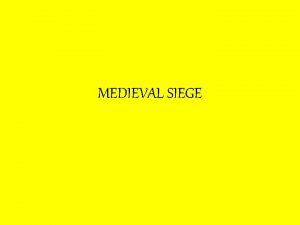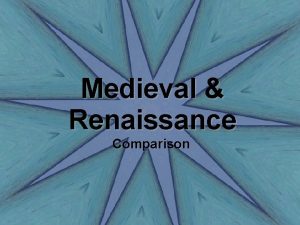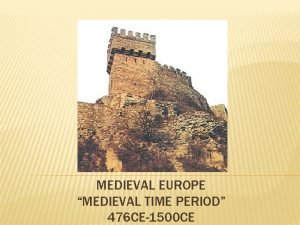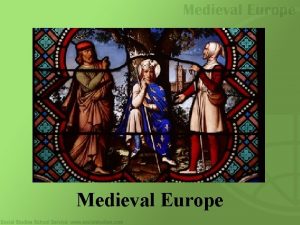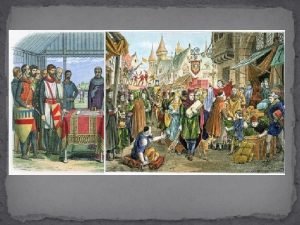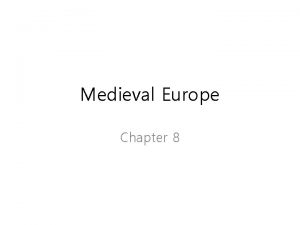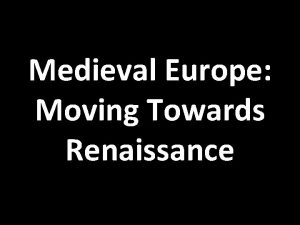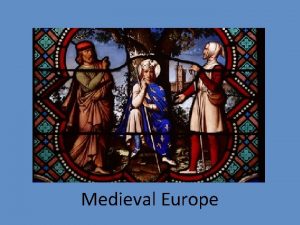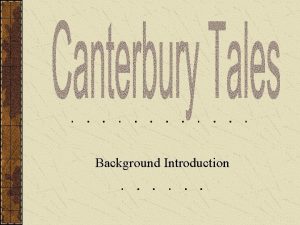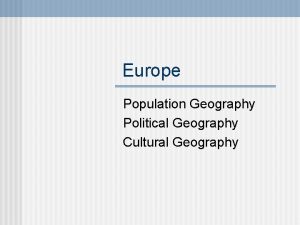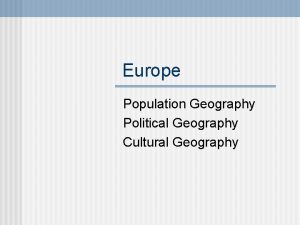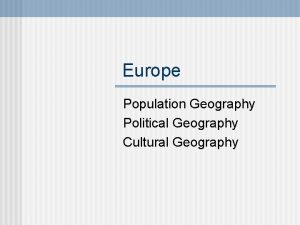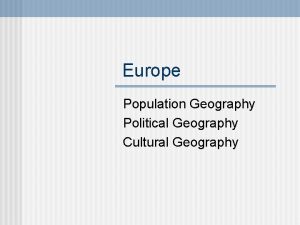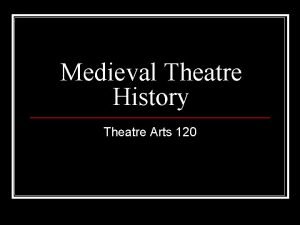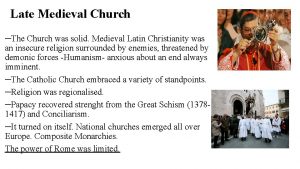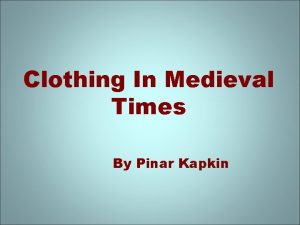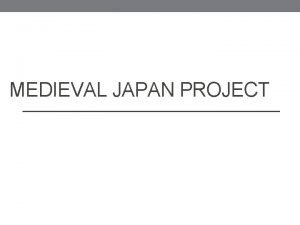Medieval Europe Lesson 1 Geography of Europe Europe























































- Slides: 55

Medieval Europe

Lesson 1: Geography of Europe

Europe • Europe = 2 nd smallest continent • It goes from the Arctic Ocean to the Mediterranean Sea • Its western boundary is the Atlantic Ocean • The Ural Mountains are its eastern boundary

4 major land regions in Europe • 1) the Northwest Mountains • 2) the North European Plain • 3) the Central Uplands • 4) the Alpine Mountain System

Europe’s River System • Many rivers • Serve as transportation routes • Volga River = longest river in Europe • Danube River = 2 nd longest river in Europe • Rhine River = the backbone of the busiest inland system of waterways in the western part of Europe

Waterways (Rivers) • Traders transported goods • Used the water to turn waterwheels to grind grain • Cities grew up along rivers • Fishing became part of the economy

Climate Milder Climate due to winds that are warmed by the Gulf Stream.

• Europeans began to clear the land for farming. • Deforestation = the cutting down of forests to clear the land • Most of Europe = Milder/Temperate Climate • Different areas had different conditions: -Atlantic coast = mild winters and cool summers southern -Europe = hot, dry summers and mild, rainy winters -Northwest Mountain region = cooler at higher elevations and milder at lower elevations

Lesson 2: Rulers and Invaders

A European Empire • Domesday Book kept track of the number of people in Europe. • It helped the ruler set up a tax system.

Charlemagne • Crowned emperor in 800 • Conquered lands • Forced people to become Christians • Issued written laws • Promoted learning and culture • Gave land to nobles who pledged loyalty to him

Invaders • Vikings (fierce pirates and warriors from Scandinavia) invaded the empire. • They launched several invasions. • They conquered and looted (robbed). • First, they did it to steal goods. • Later, they set up trading centers and trade routes.

William the Conqueror • Led the Normans (another group of Vikings) • They became Christians and church leaders • Adopted Frankish customs • Marched into England southern Italy

A Change in Government • Most kings were strong and just. • King John ruled with more force than others. • He demanded more military service and more money. • He sold royal positions to the highest bidders.

• English lords were angry with John’s rule. • After King John lost an important battle against France, civil war broke out.

King John “agreed” to sign the Magna Carta. The Magna Carta, or “Great Charter, ” limited royal power.

Lesson 3: Life in the Middle Ages

The Church • Most people were Christians. • Some were Jewish and Muslim. • Christians showed devotion by going on a pilgrimage to Rome or Jerusalem. To Rome or Jerusalem!!

• Jerusalem = holy city for Jews, Christians, & Muslims • Rome = holy center of Christendom (“kingdom of Christians”) • The pope (Christian leader) lived in Rome. • The pope was just as powerful as a king.

Cathedrals

Cathedrals • Entire towns worked to build these large churches. • They took decades or even hundreds or years to finish!

Monk = men who devote their lives to religion. Monastery = where monks studied, prayed, and lived. Nun = women who devote their lives to religion. Convent = where nuns studied, prayed, and lived.

Monasteries and Convents: • Served as centers of religion and education. • Monks and nuns planted and harvested crops and helped the poor. • Some monks became missionaries who are people who teach a religion to people with different beliefs.

Feudalism- a political, social, and economic system monarch lords knights serfs or peasants

Lords: • owned the land • collected a percentage of the crops • received all the income from the crops • collected taxes • maintained order • enforced laws • protected the serfs

Knights- warriors trained and prepared to fight on horseback Chivalry-- a code of behavior that stated that a true knight: • Had deep faith • Was ready to die for the church • Gave generously to all • Used his strength to stand against injustice Most knights received some land from their lords.

Feudalism Declines Serfs: • formed the base of the society • had no loyalty to anyone • were not slaves • were “tied” to the land = they could not leave it without the lord’s permission

Eventually, lords became independent of the monarch.

The Manor System • The manor system was a way of organizing agricultural labor (farming). • Manors had four parts: – 1. the manor house and village – 2. farmland – 3. meadowland – 4. wasteland (see pages 402 -403)

Being a serf was a difficult life– the church offered hope and peace.

Three-Field Rotation System


Meadowlands & Wastelands Also Provided:

The Manor System generally met all the needs of the people living there. • It even allowed for crop surpluses. • These surpluses allowed towns and cities to grow!

Guilds = a group of people united by a common interest • Guilds: – Worked together to buy large quantities of goods cheaply – Controlled the market – Guaranteed a fair price for goods – Workers such as bakers, goldsmiths, tailors, and weavers formed craft guilds – Controlled the quality and quantity of production – Protected the town’s merchants and craftspeople from having to compete with those from outside the town

Medieval Women • Most women had few rights. • Unmarried and own land? -- You would have some rights. • Until you get married– they you give up your rights.

Medieval Women • A lady– a woman of noble birth – Given little opportunity to make decisions about her own life. – A lady’s actions were directed by her father or husband. – Servants managed the lord’s business and nurses took care of the children.

Village Women • Had more work to do than ladies • Often worked on the land with their husband • Unmarried? Worked as servant girls or as agricultural (farm) workers • Could work in nearly all the trades • They were kept out of decision-making discussions.

Christine de Pisan • Earned a living by writing: – She wrote poetry and books protesting the way women were both glorified and insulted by male authors.

Lesson 4: Crusades, Trade, and the Plague

Chain Mail Armor

• The religion of Islam had spread through North Africa and Asia Minor. • Lands to the north and west of the Mediterranean Sea were mainly Christian. • Lands on the eastern shores were Muslim. • In the mid-1000 s, a group of Muslim Seljuk Turks rose up and defeated a Byzantine Empire. • This marked the decline of Byzantine control over Asia Minor.

• The Turks conquered Palestine– which Christians considered to be the Holy Land. • According to the New Testament, Palestine is where Jesus had lived and preached. • Byzantine Emperor Alexius Comnenus asked Pope Urban II in Rome for help. • He wanted Christian knights to fight against the Turks.

The Crusades • Between 1095 & 1214, eight major military expeditions were organized– these were called the Crusades. • Kings, nobles, knights, peasants, & townspeople became crusaders. • They set out to win back control of Palestine.

East and West • Crusaders marched to the East to win control of the Holy Land. • Holy Land = Palestine • Crusaders won some battles. They set up crusader states along the eastern shore of the Mediterranean Sea. • Their victories had no permanent effects HOWEVER the Crusades increased contacts between the West and the East. • This led to trade and commerce.

Trade Grows • During the early Middle Ages, people had what they needed to produce their own food, clothing, and shelter. • Over time, people began to need and want goods that were not available on the manor. • Goods reached people by way of a fair. • Merchants and craftspeople set up tents or stalls to display and sell their goods.

• Traders developed regular trade routes. • Traders and merchants traded local goods foreign goods. • Goods from Asia would reach the trader through a series of middleman (like a relay race).

The Silk Road • 4, 000 miles in length • It was several different routes or branches. • It started from the Chinese capital, Chang’an. • See page 409.

• Caravans to China carried gold, ivory, and precious stones. • Caravans from China brought silk, furs, ceramics, jade, bronze objects, and iron. • Ideas traveled both ways.

• The Silk Road was difficult and dangerous to travel on. • Bandits made travel unsafe. • Forts and defensive walls were built along part of the road to protect the caravans.

Marco Polo • In 1271, Marco Polo left Italy for China. • He remained there for 17 years.

Many states were united under the Mongol Empire. As a result: • The Silk Road became an important path for communication between different parts of the Empire. • It became safer to travel under the protection of the Mongols.

The Plague • The Plague hit Europe at the height of its strength. • It was the bubonic plague, a very aggressive epidemic. • An epidemic is the rapid spread of a disease over a wide area.


• Ships carried the rats from country to country. • They didn’t know how the Plague was spread. • Some thought you could get it by looking at someone who had the Plague. • The Plague killed about one-fourth to one-third of Europe’s population from 1347 -1352. • A positive side? Less people meant the serfs became more valuable to lords and enjoyed a higher standard of living and more independence.
 Which actions did french kings take to increase royal power
Which actions did french kings take to increase royal power Medieval kingdoms in europe lesson 1
Medieval kingdoms in europe lesson 1 How do mountains and plains define eastern europe
How do mountains and plains define eastern europe 13 kingdoms
13 kingdoms Geography of medieval japan
Geography of medieval japan Medieval africa geography
Medieval africa geography Medieval christian europe part 2 practice
Medieval christian europe part 2 practice Medieval hierarchy
Medieval hierarchy “how did the vikings change medieval europe?”
“how did the vikings change medieval europe?” Topic 1 medieval christian europe
Topic 1 medieval christian europe How to write an frq for ap human geography
How to write an frq for ap human geography 5 themes of geography ap human geography
5 themes of geography ap human geography Proruption ap human geography
Proruption ap human geography Sweden physical features
Sweden physical features The cultural geography of europe chapter 12 answer key
The cultural geography of europe chapter 12 answer key Europe's geography cloze notes
Europe's geography cloze notes Physical features of northern europe
Physical features of northern europe Shatter belt definition ap human geography
Shatter belt definition ap human geography Chapter 13 human geography of europe
Chapter 13 human geography of europe What countries in northwestern europe
What countries in northwestern europe Lesson 1: an introduction to oceania
Lesson 1: an introduction to oceania Economics unit 2 lesson 1
Economics unit 2 lesson 1 Lesson 1 physical geography of southeast asia
Lesson 1 physical geography of southeast asia Choke points definition ap human geography
Choke points definition ap human geography What influenced mexico's political and social structures
What influenced mexico's political and social structures Lesson 1 latin america africa and the middle east
Lesson 1 latin america africa and the middle east Chapter 2 lesson 1 studying geography
Chapter 2 lesson 1 studying geography States west of the mississippi river
States west of the mississippi river The human world lesson 1 global cultures
The human world lesson 1 global cultures Studying geography economics and citizenship
Studying geography economics and citizenship Lesson 1 studying geography
Lesson 1 studying geography Indian subcontinent map
Indian subcontinent map For which reason did persia attract foreign interest
For which reason did persia attract foreign interest Chapter 15 lesson 2 ideas and art of the renaissance
Chapter 15 lesson 2 ideas and art of the renaissance Lesson 2 the renaissance in northern europe
Lesson 2 the renaissance in northern europe The reformation in europe lesson 1
The reformation in europe lesson 1 Nationalism in europe lesson plan
Nationalism in europe lesson plan The new order in europe lesson 4
The new order in europe lesson 4 Head crusher torture
Head crusher torture Structure of medieval society
Structure of medieval society The medieval ballad
The medieval ballad Siege engines
Siege engines Aristotelian scholasticism
Aristotelian scholasticism Medieval and renaissance differences
Medieval and renaissance differences Statul medieval francez
Statul medieval francez Postmodernism british literature
Postmodernism british literature Parts del castell
Parts del castell Gossip's bradle
Gossip's bradle Empire theatre collapse
Empire theatre collapse Medieval theater timeline
Medieval theater timeline Medieval times shields
Medieval times shields Medieval times food and drink
Medieval times food and drink British literature notes
British literature notes Medieval ballad characteristics
Medieval ballad characteristics Characteristics of a ballad
Characteristics of a ballad Dark ages vs middle ages
Dark ages vs middle ages
